Our home has many can-light ceiling fixtures. We replaced the original incandescent bulbs with CFL in many of them and noticed some cost savings on our electric bill for several years. More recently we added some LED style.
Bulb costs, duration of use, and total cost of use are some of the quantities tabulated in the chart below from wikipedia. I don’t know how recent are the values. But, they illustrate the cost savings with LED. With LED costs coming down, the savings is improving.
The main problem with an incandescent bulb is that about 75% of the energy needed to operate it is wasted as heat energy to the surroundings. Only about 25% goes toward making light energy. The CFL and LED bulbs convert a much greater fraction of their operating energy into light energy. As a result, they need less electrical energy to produce the same light output as an incandescent.
Recently, I obtained a pair of diffraction grating glasses. The transparent films are embedded with vertical and horizontal openings to allow light to pass through. It is similar in effect to viewing a distant street lamp at night through a window curtain sheer fabric. The light is spread horizontally by the vertical thread openings and is spread vertically by the horizontal threads.
The films in these glasses have 13,500 openings/inch or 530 openings/mm. The distance between the very small openings causes the colors of light to be spread out by different amounts. Red is the longer wavelength and is spread out the most. Blue is the least.
I held the glasses over the camera lens and looked up toward two ceiling lights and saw this effect. At left-center is an LED light fixture. At right -center is a CFL. Pretty? Yes. There is a lot of physics at play. Lets take it one step at a time.
Incandescence
First we look at a standard incandescent bulb. It has a hot wire glowing inside to make it emit light. The inside of the glass is frosted. Here is the view through the diffraction glasses. Barely left of center is the fixture with the bulb. To the far right is a clear spread of the full color spectrum emitted from the bulb’s hot filament. All of those colors mix in the vision center of your brain to make what is called white light.
The color spectrum can be analyzed with the right equipment. One can tell how much light is produced at each portion of the spectrum. Such an analysis was done by Geoffrey Morrison at Sound & Vision. This chart shows the typical light emission by an incandescent bulb. It is a smooth continuous spectrum. Notice the large amount toward the red end of the spectrum. Not measured, at longer wavelengths of infrared, is the heat emission by the bulb.

Incandescent | ©Sound and Vision
Compact Fluorescent CFL
This image shows the CFL in my ceiling fixture at the center of the frame. The diffraction glasses cause a spectrum of 3 or 4 distinct separate color images of the bulb clearly visible to the far right and left. There is not a continuous full spectrum as with the incandescent bulb. Our vision center receives the red, green, and blue parts of the spectrum and combines them to make an acceptable version of white light in our brain.
Analysis of the spectrum shows this chart of colors. Notice the peak emissions of red-orange, green, blue, and a violet. The CFL contains mercury vapor. When electrically excited, the vapor emits strongly in these four colors. We see images of the bulb in those colors.
In addition, the mercury vapor emits UV ultraviolet light. The UV is absorbed by the white phosphor coating on the inside of the glass tube. The phosphor reradiates the energy to increase the perception of white light.

CFL | ©Sound and Vision
Light Emitting Diode LED
This image shows the LED bulb through the diffraction glasses. The colors more closely match those of an incandescent bulb. The spectrum appears continuous. It tends to be pleasing to the eye for most people.
Here is an analysis of a typical LED lamb. There is a strong blue and yellow detected by the instrument. If you remember how colors of light mix, you might recall that red + green + blue = white to the eye. It is the basis of the RGB color mixing on a television screen.
In this bulb there is not a strong red or green. However, yellow is a mixture of red and green. So, yellow + blue = white. Don’t confuse mixing of light with that of pigments.

LED | ©Sound and Vision




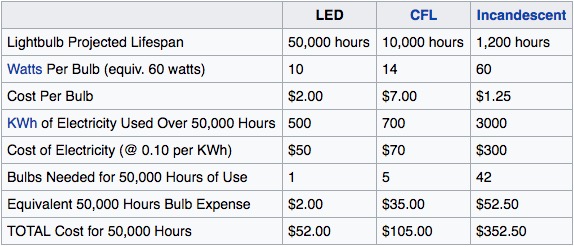
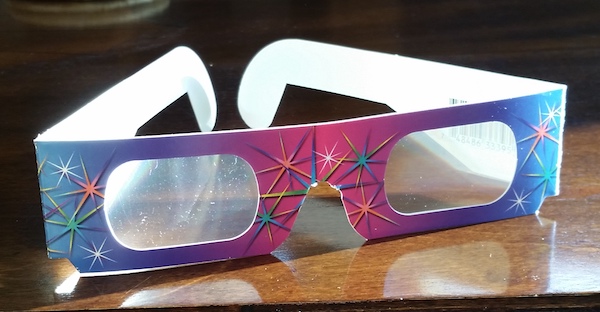
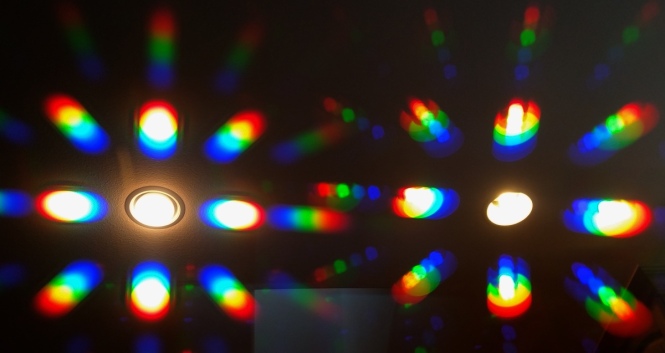
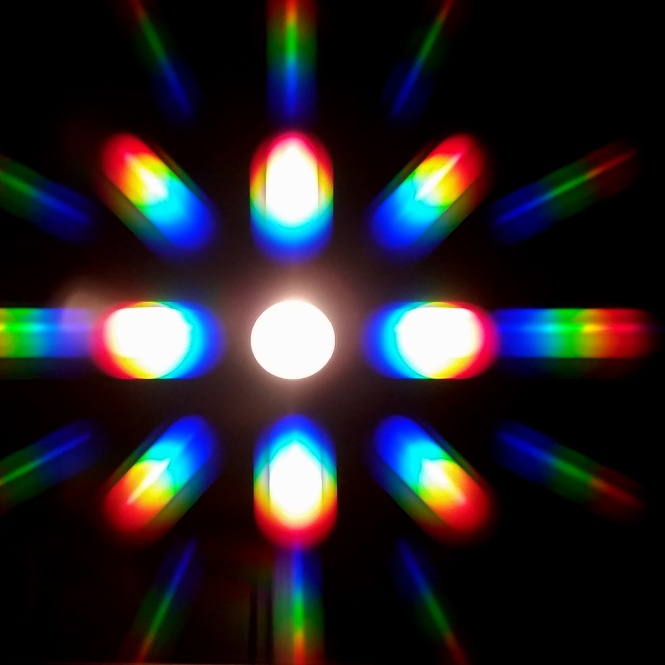
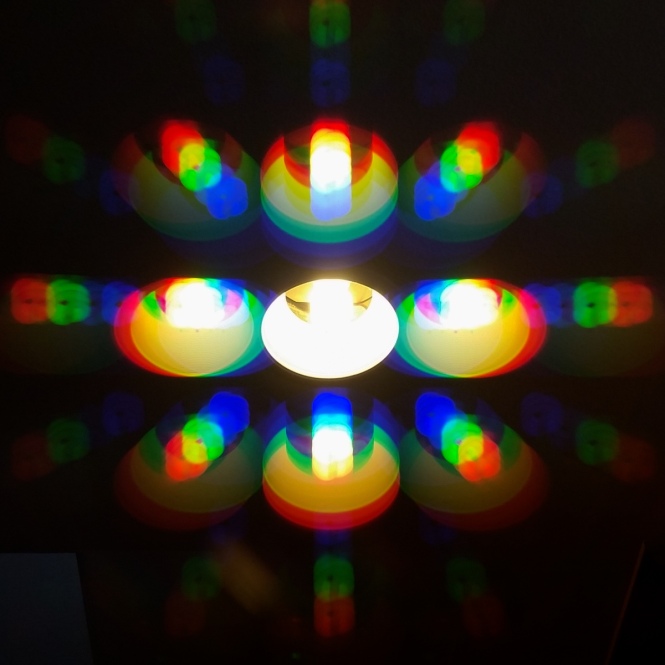
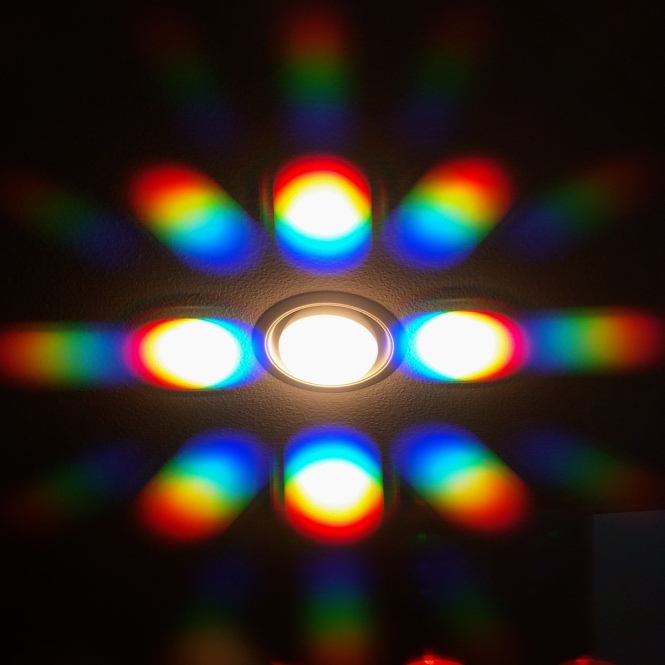
We are slowly converting to LED too and like the savings and lights.
Good. They are finding their way into all kinds of good applications.
Really interesting. I did not realize that the LED light was so much more similar to incandescent to our eyes. I sure love my LED lights!
They make a great difference in your quilting room.
They’ve just installed LEDs in the exterior hallways of my apartment complex, and they’re fabulous. They had fluorescent with covers before. Now, with new canister fixtures and those lights, anyone who’s up to something will be doing it in next-to-daylight.
I still have a stash of 100 and 150 watt incandescents, but they’re for a very specific purpose. When we have our freezes down here, I drape any plants I can’t move inside with freeze cloth, then tuck a couple of work lights in with them, using those bulbs. The heat is sufficient to keep the little babies from freezing — a testimony to what you said about that heat loss!
We still use some incandescents in places where the light will be ON for short times. The CFL and LED don’t last as long if turned on and off often.
We have some new street lights nearby that are LED. They cast light downward and less up to the sky.
Very interesting post!!! We have a combination of bulbs, too. I don’t particularly care for the CFL. When the incandescent bulb in the lamp in my bedroom blew, I put a CFL in… Dad had bout a lot of them from Publishers Clearing House… GEEZ! Anyway, I used to dim the light with with the dimmer sometimes if i didn’t want it as bright. The CFL bulb won’t dim…
Thanks.
No. They won’t do that. You can buy LED bulbs that dim. For dimmer situations, I still use regular incandescents.
Thanks Jim! Very fine post. It is something Lisa and I have had to consider because of our recent reno. Do you wear the glasses around the house and tell Melanie you are ‘flashing back’ to the sixties? Take care. Bob
Thank you, Bob.
Yes, I wear those glasses and dress up in a leisure suit for her entertainment. 🙂
I have LED lighting in my sewing room and love it. Thank you for the information. I never knew.
It certainly helps when we can see clearly.
Fascinating! I sure like the lower electric bills. 🙂
This is an interesting analysis. The comparison grid shows that the cost of bulbs is far outweighed by the savings in electricity, which is why the savings for LED’s are not intuitive. I think this is true across the consumer spectrum. For example, the ACA health system focuses on the long-term benefits of preventive medicine (screenings for cancer, heart problems, cholesterol, etc.) as opposed to reactive medicine (treat problems as they occur.) Sorry, but I couldn’t resist.
I think you made an excellent point, Jim. No need to be sorry.
This is something I’m really interested in now. I’ve gradually switched all of my light bulbs to LEDS, and I just love the Daylight (5000K – 6500K). They are always a bit more expensive but that white light is just invaluable for my continuous light photography.
I’m glad they are helping you. The results we see are certainly marvelous.